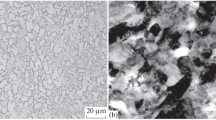Abstract
The modern development of technology and industry depends to a large extent on improving the quality and performance of equipment. Additive technologies allow the production of optimized designs and equipment while maintaining all operational characteristics. The use of additive technologies in the production of parts for aerospace engineering requires a thorough study of the operational properties of materials at each stage of production, a comparative assessment of the test results with the parameters of products obtained by traditional technologies, as well as predicting the characteristics of the final product. In this work, a study of changes in the chemical and phase compositions, microstructure and microhardness of the VT6 titanium alloy samples was carried out at various stages of production: initial cast billet; a powder obtained by plasma centrifugal spraying of an ingot and a product obtained by selective laser melting (SLM). Analysis of the samples’ chemical composition was carried out on an X-ray fluorescence spectrometer with wave dispersion Rigaku Primus ZSX II, X-ray structural studies—on a Rigaku MiniFlex 600 diffractometer (CuKα-radiation, λ = 1.54178 Å), equipped with a linear (1-D) D/teX semiconductor detector. The microstructure study of powder (granular) samples was carried out using the methods of optical and scanning electron microscopy, the measurement of microhardness—on a microhardness tester LECO M-400-H by the Vickers method. It was shown that microstructure of the samples after centrifugal sputtering was a combination of two solid solutions based on the hexagonal titanium modification (HCP) with slightly different crystal lattice parameters due to difference in concentrations of the alloying elements. Chemical composition of the alloy after SLM practically did not differ from the alloy in the initial state.








Similar content being viewed by others
REFERENCES
Dobrovol’skii, M.V., Zhidkostnye raketnye dvigateli (Liquid Propellant Rocket Engines), Moscow: Mosk. Gos. Tekh. Univ. im. N.E. Baumana, 2005.
Patsuk, E.B. and Korshakevich, I.S., Problems and prospects for development of rocket and space industry, Aktual. Probl. Aviats. Kosm., 2017, vol. 3, no. 13, pp. 392–394.
Krishtofor, A.P., Change of Russia’s competitive positions in the world market of space products, Vestn. Univ., 2019, no. 5, pp. 86–92.
Milewski, J.O., Additive Manufacturing of Metals: From Fundamental Technology to Rocket Nozzles, Medical Implants, and Custom Jewelry, New York: Springer-Verlag, 2017.
Logacheva, A.I., Sentyurina, Zh.A., and Logachev, I.A., Additive technologies for production of critical products from metals and alloys (review), Perspekt. Mater., 2015, no. 5, pp. 5–15.
Gasser, A., Backes, G., Kelbassa, I., Weisheit, A., and Wissenbach, K., Laser additive manufacturing. Laser metal deposition (LMD) and selective laser melting (SLM) in turbo-engine application, Laser Tech. J., 2010, vol. 7, no. 2, pp. 58–63.
Carter, L.N., Martin, C., Withers, P.J., and Attallah, M.M., The influence of the laser scan strategy on grain structure and cracking behavior in SLM powder-bed fabricated nickel superalloy, J. Alloys Compd., 2014, vol. 615, pp. 338–347.
Bikas, H., Stavropoulos, P., and Chryssolouris, G., Additive manufacturing methods and modeling approaches: a critical review, Int. J. Adv. Manuf. Technol., 2016, vol. 83, nos. 1–4, pp. 389–405.
Yadroitsev, I., Bertrand, Ph., and Smurov, I., Parametric analysis of the selective laser melting process, Appl. Surf. Sci., 2007, vol. 253, no. 19, pp. 8064–8069.
Sudarshan, T.S., Additive Manufacturing: Innovations, Advances, and Applications, Boca Raton, FL: CRC Press, 2016.
Kruth, J.-P., Vandenbroucke, B., van Vaerenberg, J., and Mercelis, P., Benchmarking of different SLM/SLS processes as rapid manufacturing techniques, Proc. Int. Conf. on Polymers and Moulds Innovations (PMI), Gent, 2005. https://ris.utwente.nl/ws/portalfiles/portal/ 5676701/Wa1021.pdf.
Yadroitsev, I., Thivillon, L., Bertrand, Ph., and Smurov, I., Strategy of manufacturing components with designed internal structure by selective laser melting of metallic powder, Appl. Surf. Sci., 2007, vol. 254, no. 4, pp. 980–983.
Meier, H., Haberland, Ch., and Matwiss, U., Experimental studies on selective laser melting of metallic parts, Werkstofftech, 2008, vol. 39, no. 9, pp. 665–670.
Yasa, E. and Kruth, J.-P., Microstructural investigation of Selective Laser Melting 316L stainless steel parts exposed to laser remelting, Procedia Eng., 2011, vol. 19, pp. 389–395.
Kruth, J.P., Froyen, L., van Vaerenbergh, J., Mercelis, P., Rombouts, M., and Lauwers, B., Selective laser melting of iron-based powder, J. Mater. Process. Technol., 2004, vol. 149, nos. 1–3, pp. 616–622.
Chen, G., Zhao, S.Y., Tan, P., Wang, J., Xiang, C.S., and Tanga, H.P., A comparative study of Ti–6Al–4V powders for additive manufacturing by gas atomization, plasma rotating electrode process and plasma atomization, Powder Technol., 2018, vol. 333, pp. 38–46.
Sun, Y., Aindow, M., and Hebert, R.J., Comparison of virgin Ti–6Al–4V powders for additive manufacturing, Addit. Manuf., 2018, vol. 21, pp. 544–555
Ashgriz, N., Handbook of Atomization and Sprays: Theory and Applications, New York: Springer-Verlag, 2011.
Logachev, I.A., Potapkin, P.A., Grigorovich, K.V., Zheleznyi, M.V., and Komolova, O.A., Evolution of the structure and composition of VT6 alloy from ingot to alloyed material, Materialy Mezhdunarodnoi nauchnoi konferentsii “Sovremennye materialy i peredovye proizvodstvennye tekhnologii (SMPPT–2019),” Tezisy dokladov (Proc. Int. Sci. Conf. “Modern Materials and Advanced Manufacturing Technology (MMAMT–2019),” Abstracts of Papers), St. Petersburg, 2019, p. 86.
Logachev, I.A., Zheleznyi, M.V., Potapkin P.A., Komolova O.A., and Grigorovich, K.V., Investigation of VT6 alloy samples at all stages of part production using SLS method, Trudy Mezhdunarodnoi nauchnoi konferentsii imeni akademika A.M. Samarina “Fiziko-khimicheskie osnovy metallurgicheskikh protsessov,” Tezisy dokladov (Proc. Acad. Samarin’s Int. Sci. Conf. “Physical and Chemical Foundations of Metallurgical Processes,” Abstracts of Papers), Moscow, 2019, p. 95.
Ozerskoi, N.E., Popovich, A.A., and Ermakov, B.S., Preparation of spherical powders of VT6 alloy for use in selective laser melting technology, Nauchno-Tekh. Ved. S.-Peterb. Politekh. Univ., Estestv. Inzh. Nauki, 2019, no. 14, pp. 107–115.
Author information
Authors and Affiliations
Corresponding author
Additional information
Translated by Sh. Galyaltdinov
About this article
Cite this article
Logachev, I.A., Zheleznyi, M.V., Komolova, O.A. et al. Change Dynamics of Alloy VT6 Structure from Ingot to Alloyed Material. Steel Transl. 50, 592–598 (2020). https://doi.org/10.3103/S0967091220090065
Received:
Revised:
Accepted:
Published:
Issue Date:
DOI: https://doi.org/10.3103/S0967091220090065



